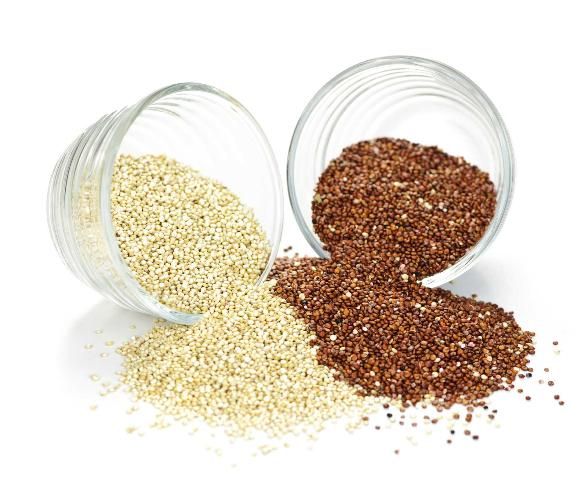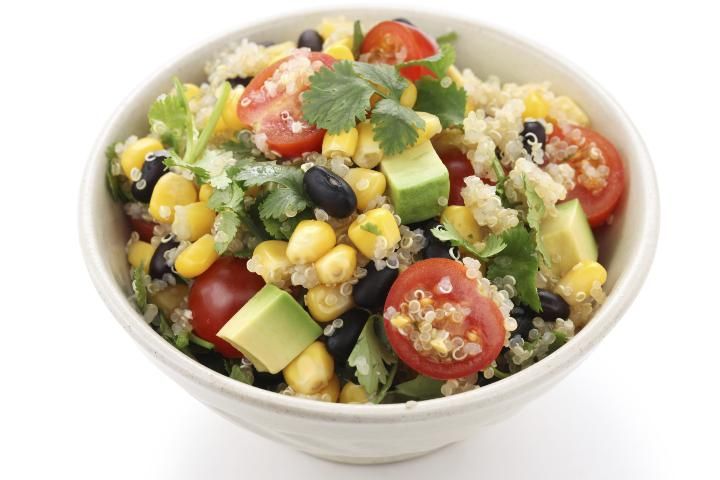The US Department of Agriculture's MyPlate nutrition guide recommends that Americans consume half of their grains from whole grain foods. Whole wheat bread and oatmeal are whole grain foods that are familiar to most Americans, but lots of other whole grain foods are also available. An example of a less familiar whole grain food is quinoa (pronounced keen-wa). Quinoa is a nutritious seed that is simple to prepare. It can be served as a hot cereal or side dish, as a cold salad similar to pasta salad, or it can be used in recipes in place of rice or other grains. It also has the advantage of being gluten free, which is a must for people diagnosed with celiac disease. Continue reading to learn more about quinoa and what it has to offer.

Credit: Elena Elisseeva/iStock/Thinkstock.com
Facts about Quinoa
Quinoa (plant species: Chenopodium quinoa) is a native plant from the Andean region of South America (Repo-Carrasco, Espinoza, & Jacobsen, 2003). The quinoa plant produces seeds that come in different colors, including black, red, and ivory (Vega-Gálvez et al., 2010). Ivory, sometimes referred to as yellow, is the variety most commonly sold in stores. It is noteworthy that the quinoa plant can be grown without pesticides, because the plant produces a natural substance that prevents the invasion of pests, so additional chemicals are not needed for its growth (De Geyter, Lambert, Geelen, & Smagghe, 2007). However, whether quinoa can be labeled as "organic" depends on how it was grown and produced.
The substances that prevent pest damage in quinoa also give it a bitter flavor. For this reason, quinoa is soaked and rinsed multiple times before it is packaged for sale (Ruales & Nair, 1992). This process results in quinoa that has a milder, well-liked flavor. However, quinoa seeds are not the only edible form of the plant—the seeds can be made into flakes or ground into a flour.
Quinoa Nutrition
Quinoa has several important nutritional benefits that make it a good choice when searching for alternatives to whole grain foods. First, it does not contain gluten (Vega-Gálvez et al., 2010). Gluten is a protein found in wheat, rye, barley, and products made with these foods. Because quinoa is naturally gluten-free, it can be an ideal substitute for whole grains that contain gluten and can be a great way for people with celiac disease, gluten sensitivity, or a wheat allergy to add variety to their diet (Vega-Gálvez et al., 2010). (For more information about gluten sensitivity and celiac disease, see the EDIS publication FY1369, Understanding Gluten Sensitivity and Celiac Disease.) Compared with other common grains—such as couscous (ground hard wheat), white rice, and barley—quinoa is comparable and even provides higher levels of many nutrients, vitamins, and minerals per serving (United States Department of Agriculture, Release 26) (Table 1). Similar to whole grains, quinoa provides a source of soluble and insoluble dietary fibers that can help maintain intestinal health (Repo-Carassco et al., 2003; Dixit, Azar, Gardner, & Palaniappan, 2011). People who have high intakes of dietary fiber tend to have lower blood pressure, cholesterol levels, and blood sugar, and the soluble fiber in quinoa may play a role in reducing heart disease (Dixit et al., 2011). Quinoa, which is also naturally low in sodium (USDA, Release 26), is a good choice for everyone, especially people with high blood pressure and other diseases where consuming too much sodium is a concern.
Storing and Preparing Quinoa
Raw quinoa grains can be stored at room temperature in its original packaging, but it should be used before its "best by" date. The seed form of quinoa can be used as a replacement for rice, couscous, or pasta in a one-to-one ratio (i.e., substitute one cup of quinoa for one cup of another grain listed in Table 1). Quinoa is prepared similarly to rice with two parts liquid to one part dry seed. Water or a broth, such as vegetable or chicken, can be used to make quinoa, but if broth is used, choose low-sodium or sodium-free broth to keep the sodium content low. To cook quinoa, add the seeds and liquid to a pot and cook over high heat. Once a vigorous boil is reached, reduce the heat to low, cover the pot, and simmer for 15 minutes. For recipe and serving suggestions (and any other preparation details), refer to the package directions. Once cooked, handling and storage guidelines is as of cooked rice.
Adding Quinoa to Your Diet
Quinoa can be enjoyed hot or cold and in many different recipes. The type of quinoa used in a recipe (i.e., red, black, or ivory) is up to you, but some types work better in certain recipes. For example, red quinoa holds its shape the best after cooking, so it is particularly good for cold salads or other dishes when a distinct shape is desired or when you want to add color to a meal (Whole Grain Council, 2013). Black quinoa has more of an earthy, sweet taste and maintains its unique color when cooked (Whole Grain Council, 2013). While black and red quinoa can be used in these specific cases, ivory is the most common type found in stores, and it can be used in place of the other color varieties for any recipe using the seed form of quinoa. Cooked quinoa can also be eaten for breakfast, with honey, almonds, and/or fruit to add taste, texture, and color. Another great way to add quinoa to your diet is in casseroles or soups or to use it in place of breadcrumbs when baking chicken or fish. Additionally, quinoa in the form of flour is a great alternative in gluten-free baking. Quinoa can be used in place of white or whole wheat flour when baking. For other ideas on how to include quinoa in your diet, try searching the Internet or browsing through cookbooks that focus on alternatives to grains.
Summary
Quinoa is a food that counts as a whole grain and can add variety to your diet. It also has the added benefits of being gluten-free and easy to prepare. It can be enjoyed at breakfast as a hot cereal, or it can be served at other meals as a hot or cold side dish. The next time you are looking to add a food that counts toward your intake of whole grains, or you do not know what to eat for breakfast, lunch, dinner, or a snack, then try some quinoa!
Recipe
Try this simple recipe and see how delicious this whole-grain equivalent food can be.
Southwest Quinoa Salad
Makes 7 tightly packed cups.

Credit: Toru Uchida/iStock/Thinkstock.com
Ingredients
- 1 cup dry quinoa
- 1 cup reduced-sodium chicken broth
- 1 cup water
- 1 pint grape tomatoes (sliced)
- 2 cups fresh spinach (cleaned and chopped)
- 1 can (15.52 oz) reduced-sodium black beans (rinsed, drained, and dried)
- 1 cup frozen corn (thawed)
- 1 tsp minced garlic
- Add diced avocado (if desired)
- Cayenne pepper to taste (if desired)
Preparation
- Bring quinoa, broth, and water to a vigorous boil. Reduce to low heat, cover, and let simmer for 15 minutes.
- While quinoa is cooking, mix together tomatoes, spinach, black beans, and corn in a large bowl.
- When quinoa is ready, add it to other ingredients. Mix thoroughly.
- Add garlic and cayenne. Mix until ingredients are evenly distributed.
- Salad can be eaten right away, but may taste better when chilled.
- Additional spices can be added for desired taste.
Nutritional Information
Serving size: 1/2 cup salad
- Calories: 85 kcals
- Total Fat: 1 g
- Saturated Fat: 0 g
- Trans Fat: 0 g
- Cholesterol: 0 g
- Sodium: 82 mg
- Total Carbohydrates: 16 g
- Dietary Fiber: 3 g
- Sugars: 1 g
- Protein: 4 g
References
DeGeyter, E., Lambert, E., Geelen, D., & Smagghe, G. (2007.) Novel advances with plant saponins as natural insecticides to control pest insects. Pest Technology, 1(2), 96–105.
Dixit, A., Azar, K., Gardner, C., & Palaniappan, L. (2011.) Incorporation of whole, ancient grains into a modern Asian Indian diet to reduce the burden of chronic disease. Nutr. Rev., 69(8), 479–488. doi: 10.1111/j.1753-4887.2011.00411.x.
Oldways Whole Grains Council. (n. d.) Types of quinoa. http://wholegrainscouncil.org/whole-grains-101/types-of-quinoa (March 2017).
Repo-Carrasco, R., Espinoza, C., & Jacobsen, S. E. (2003.) Nutritional value and use of the Andean crops quinoa (Chenopodium quinoa) and kañiwa (Chenopodium pallidicaule). Food Reviews International, 15(1 & 2), 179–189. doi: 10.1081/FRI-120018884.
Ruales, J., & Nair, B. M. (1992.) Nutritional quality of the protein in quinoa (Chenopodium quinoa, Willd) seeds. Plant Foods Hum. Nutr., 42, 1–11.
USDA Agricultural Research Service. (n. d.) National Nutrient Database for Standard Reference. USDA Food Composition Databases. https://fdc.nal.usda.gov/fdc-app.html#/food-details/168874/nutrients (May 2022)
Vega-Gálvez, A., Miranda, M., Vergara, J., Uribe, E., Puente, L., & Martinez, E. (2010.) Nutrition facts and functional potential of quinoa (Chenopodium quinoa Willd.), an ancient Andean grain: a review. Journal of the Science of Food and Agriculture, 90(15), 2541–2547. doi: 10.1002/jsfa.4158.